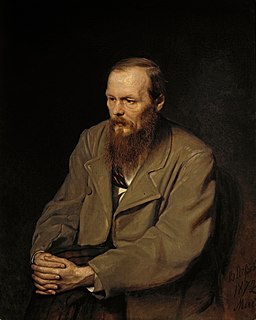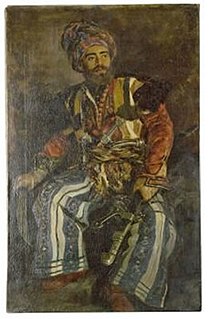Related Research Articles

Fyodor Mikhailovich Dostoevsky, sometimes transliterated as Dostoyevsky, was a Russian novelist, short story writer, essayist, and journalist. Dostoevsky's literary works explore the human condition in the troubled political, social, and spiritual atmospheres of 19th-century Russia, and engage with a variety of philosophical and religious themes. His most acclaimed novels include Crime and Punishment (1866), The Idiot (1869), Demons (1872), and The Brothers Karamazov (1880). Dostoevsky's body of works consists of 12 novels, four novellas, 16 short stories, and numerous other works. Many literary critics rate him as one of the greatest novelists in all of world literature, as multiple of his works are considered highly influential masterpieces. His 1864 novella Notes from Underground is considered to be one of the first works of existentialist literature; this has resulted in Dostoevsky being looked upon as both a philosopher and theologian as well.
An autobiographical novel is a form of novel using autofiction techniques, or the merging of autobiographical and fictive elements. The literary technique is distinguished from an autobiography or memoir by the stipulation of being fiction. Because an autobiographical novel is partially fiction, the author does not ask the reader to expect the text to fulfill the "autobiographical pact". Names and locations are often changed and events are recreated to make them more dramatic but the story still bears a close resemblance to that of the author's life. While the events of the author's life are recounted, there is no pretense of exact truth. Events may be exaggerated or altered for artistic or thematic purposes.

War and Peace is a literary work mixed with chapters on history and philosophy by the Russian author Leo Tolstoy, first published serially, then published in its entirety in 1869. It is regarded as one of Tolstoy's finest literary achievements and remains an internationally praised classic of world literature.

Constance Clara Garnett was an English translator of nineteenth-century Russian literature. She was the first English translator to render numerous volumes of Anton Chekhov's work into English and the first to translate almost all of Fyodor Dostoevsky's fiction into English. She also rendered works by Ivan Turgenev, Leo Tolstoy, Nikolai Gogol, Ivan Goncharov, Alexander Ostrovsky, and Alexander Herzen into English. Altogether, she translated 71 volumes of Russian literature, many of which are still in print today.

The Death of Ivan Ilyich, first published in 1886, is a novella by Leo Tolstoy, considered one of the masterpieces of his late fiction, written shortly after his religious conversion of the late 1870s.

The Cossacks is a short novel by Leo Tolstoy, published in 1863 in the popular literary magazine The Russian Messenger. It was originally called Young Manhood. Both Ivan Turgenev and the Nobel prize-winning Russian writer Ivan Bunin gave the work great praise, with Turgenev calling it his favourite work by Tolstoy. Tolstoy began work on the story in August 1853. In August 1857, after having reread the Iliad, he vowed to completely rewrite The Cossacks. In February 1862, after having lost badly at cards he finished the novel to help pay his debts. The novel was published in 1863, the same year his first child was born.

This is a list of works by Russian writer Leo Tolstoy (1828–1910), including his novels, novellas, short stories, fables and parables, plays and non-fiction.

"Croesus and Fate" is a short story by Leo Tolstoy that is a retelling of a Greek legend, classically told by Herodotus, and Plutarch, about the king Croesus. It was first published in 1886 by Tolstoy's publishing company The Intermediary. Tolstoy's version is shorter than that by Herodotus, and Tolstoy's characterization of Croesus was designed to parallel the title character in his 1886 novella The Death of Ivan Ilych.

Count Lev Nikolayevich Tolstoy, usually referred to in English as Leo Tolstoy, was a Russian writer who is regarded as one of the greatest authors of all time. He received nominations for the Nobel Prize in Literature every year from 1902 to 1906 and for the Nobel Peace Prize in 1901, 1902, and 1909. That he never won is a major controversy.
Rosemary Lilian Edmonds, nee Dickie, was a British translator of Russian literature whose versions of the novels of Leo Tolstoy have been in print for 50 years.

"After the Ball" is a short story by the Russian writer Leo Tolstoy, written in the year 1903 and published posthumously in 1911. The short story serves as an example of Tolstoy's commentary on high culture and social governance, as explored through one man's experience with love.
"Evil Allures, But Good Endures" is a short story by Leo Tolstoy written in 1885. It is commonly included in the massively-reproduced collection Twenty-three Tales.
"The Porcelain Doll" is an 1863 letter by Leo Tolstoy and his wife Sonya Tolstoy to the sister of his wife, which is treated by literary critics as a short story. In this story, according to literary critic David Holbrook, Tolstoy tells of his concern for his wife and how he had dreamed of Sonya entering his room at night. Later in the story, the woman turns into a porcelain doll that needs protection from the vulnerability of shattering. According to literary critic Randall Jarrell, who examined the piece, it was written six months after Tolstoy married Sonya.
"Lucerne: From The Recollections Of Prince Nekhliudof" is a first person narrative, in the form of diary and based on personal experiences, written by Leo Tolstoy in 1857 and translated into English in 1899 by Nathan Haskell Dole. It takes the form of a travel diary of someone in Lucerne, Switzerland.
"The Bear Hunt" is a short story by Leo Tolstoy written in 1872. It was translated as Desire Stronger than Necessity in 1888 by Nathan Haskell Dole.
"A Dialogue Among Clever People" is a short story by Leo Tolstoy published in 1892. Aylmer Maude was one of the first translators.
"There Are No Guilty People" is a short story by Leo Tolstoy written in 1909. According to the Cambridge Companion on Tolstoy, the work is directed against the death penalty. It was incomplete, and when published after Tolstoy's death, resulted in a flood of letters, the reaction mixed. The government tried to censor the work, sentencing one person distributing copies of it to prison.
"Three Days in the Village" is a short story by Leo Tolstoy written in 1909, one year before Tolstoy's death. Although classified as fiction, it is autobiographical in nature and details Tolstoy's life on his estate and his travels to nearby villages, and the contrasts between the two. It was translated by Louise Maude and Aylmer Maude.
"The Godson" is a short story by Leo Tolstoy published in 1886. Inessa Medzhibovskaya, professor of English at New School for Social Research, describes it as the tale of a godson who is forbidden to open a certain sealed room in his godfather's palace, but then opens it and is banished, leading to his need for redemption.
"Ilyás" is a short story by Leo Tolstoy written in 1885. It is the story of the farmer, Ilyas, who grew up successful but loses his fortune through mistake, in the end only finding peace without having property.
References
- ↑ Janko Lavrin (2014). Tolstoy: An Approach Bound with Dostoevsky: A Study. Taylor & Francis. p. 82.
- ↑ Inessa Medzhibovskaya (2009). Tolstoy and the Religious Culture of His Time: A Biography of a Long Conversion, 1845-1885. Lexington Books. p. 297.
- ↑ The Berkeley Undergraduate Journal. University of California, Berkeley. Undergraduate Programs. 1990.
- ↑ Orwin (2002). The Cambridge Companion to Tolstoy. Cambridge University Press. p. 173.
- ↑ Henry W. Pickford (2015). Thinking with Tolstoy and Wittgenstein: Expression, Emotion, and Art. Northwestern University Press.
- ↑ Ernest Joseph Simmons (2014). Tolstoy. Taylor & Francis. p. 151.